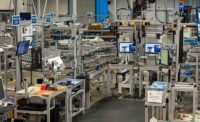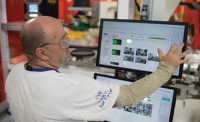IoT Promises a Future of Guaranteed Outcomes
Smart homes and autonomous driving will be built within ecosystems
















A decade or so from now, you may find yourself traveling along an interstate in a caravan. Your automobile is separated by just a few inches from the vehicle in front of you and the one behind as you speed along at 150 miles per hour.
As another vehicle enters the interstate, your car and those following you simultaneously slow down to create a gap just big enough for the new vehicle to slip into the caravan. Then the gap closes back to just a few inches. On the way to your destination, your vehicle leaves and joins a series of caravans in the same manner.
As weather and road conditions change, your entire caravan adjusts its speed and route accordingly. When your fuel begins to run low, your car calculates the best time to leave the caravan and the most efficient place to refuel.
Even though your vehicle is outfitted with numerous sensors, it cannot accomplish these feats on its own. It does so because it is tied into the Internet of Things (IoT)—or as Dwight Howard of automotive supplier Aptiv plc likes to think of it, the mesh of things.
Your car is likely to be constantly communicating wirelessly with all the vehicles around you, employing technology that evolved from adaptive radar that enhanced cruise control in the 1990s to the advanced driver assistance systems that are beginning to make automatic lane centering possible.
The Cadillac division of General Motors rolled out its first model with vehicle-to-vehicle (V2V) communication in 2017, notes Howard, Aptiv’s manager of electrical engineering product development for North America, Central America and Asia Pacific. “If you get yourself a Cadillac CTS, most likely you have that capability in it,” he says. “Of course, it is not talking to anything but another Cadillac CTS.”
But even as V2V communication evolves to the point that all vehicles are equipped to share safety-critical data, the linchpin for autonomous driving is likely to be intelligent transportation systems (ITSs), Howard speculates.
Today’s drivers can spot the early stages of ITS in the galvanized poles strung along highways. Topped with solar panels for energy, the poles sport cubicle transponders that communicate wirelessly. These connected transponders evolved from such predecessors as pavement-embedded inductive loops used to control traffic lights and the overhead transponders used in electronic toll collection.
Compared to a traffic-control system, an ITS is easier to implement. “I have to chop up pavement, lay coils and run wiring over to the traffic-control box to pick up the signal from the loops,” says Howard. And the range for an ITS is far greater than an electronic toll. “You don’t necesssarily have to be talking to cars that are a mile down the road,” Howard says of systems like E-ZPass. “You just want to...detect [vehicles] and interact with them as they pass under.”
Because ITSs collect and share data from such sources as radar and ultrasound, they have the potential to serve as the infrastructure that would be essential to autonomous driving. The power of V2V communication could be greatly enhanced by vehicle-to-infrastructure (V2X) communication, in which an ITS collects data from and about vehicles, forwards that information to a Cloud-based system for analysis, and feeds instructions back to vehicles.
Video cameras could become the greatest source of data collected by ITSs. A camera running at 60 frames a second can provide a tremendous amount of information, Howard says, estimating that video will account for nearly 40 percent of the data that artificial intelligence will analyze to control traffic.
With all that data, speed and latency pose major challenges in V2X communications, which may be solved with 5G. “The promise of 5G is you get so much more bandwidth,” Howard explains.
Although a significant amount of the infrastructure for autonomous driving is already in place and more is on the horizon, the automotive industry is moving slowly and cautiously with IoT in the interest of safety, Howard observes, noting that the auto industry is dipping its toe in IoT with less mission-critical systems, such as entertainment features. Consequently, IoT is being integrated into consumer appliances more quickly.
“Your refrigerator is not going to run over you or run off a road,” Howard explains. “So it’s a lot easier for those industries to say. ‘If something bad happens, we can just send a service guy out.’”
What’s Brewing in IoT?
IoT-enabled refrigerators, lights, thermostats, door locks and other appliances and devices are indeed beginning to flood the market. And more are on the way as consumers, business executives and government officials look to build smart homes, smart offices and smart cities.
Even brew pubs can benefit from IoT. SteadyServ Technologies, for example, employs its patented smart scales to monitor the weight of beer kegs for some 200 customers around the world. These smart scales can measure the weight of beer in everything from throwaway kegs used by craft brewers to the 100-liter kegs that are popular in Europe, explains Mike Flockenhaus, SteadyServ’s chief technology officer. Because the smart scales are designed to handle up to 350 pounds, customers can stack two kegs on each scale if cooler space is limited.
The data from the scales are transmitted via Wi-Fi or cellular connections to SteadyServ’s reporting system, Kegonomics, which customers can view on their iKeg app.
“Kegonomics will tell you exactly what’s going on from the sales-analysis perspective, a product-performance perspective and a days-on-tap perspective,” Flockenhaus says. “We can optimize your draft lineup by watching what sells and what doesn’t sell.”
Kegonomics even measures the beer that is wasted between when bartenders open a tap handle and when they place a glass underneath it.
By applying the machine learning and advanced analytics Kegonomics provides, customers can modify their inventories, anticipate their needs for special events like the Super Bowl and March Madness, adjust for changes in weather, decide which beers to take off tap and serve in bottles or cans instead, and market themselves through digital menus and social media.
“You can tie your social media accounts to your SteadyServ account,” Flockenhaus says. “When you tap a new keg, you can go out on Facebook and Twitter and tell your clientele, ‘Hey, we just tapped this rare product.’ And that will bring more feet in the door.”
Incubating IoT in a Lab
SteadyServ Technologies is one of nearly 20 start-up and established companies that have chosen to use the Indiana IoT Lab in the city of Fishers to develop, test and launch IoT products.
A cross between a think tank and a proving group, the Indiana IoT Lab was launched barely a year ago to explore employing IoT in manufacturing, agriculture and distribution. The lab provides its tenants with both a collaborative environment and infrastructure.
The lab has a large ideation space for brainstorming on prototypes. It provides laser cutters, a 3D printer, oscilloscopes, soldering irons, test and measurement equipment. Tenants have access to design apps and 5G networks, and they can purchase components like Raspberry Pis—small, low-cost, high-performance, single-board computers—from an on-site vending machine.
“The IoT Lab was envisioned for a certain kind of company that needs to make some noise,” explains the lab’s executive director, Jason Pennington.
The lab even has a wood shop so tenants can mock up what their products might look like. “If you’ve never used a 3D printer…if you’re not confident enough to use a CNC machine…if you find it difficult to approach a laser cutter, you should still be able to go to the wood shop and create something rapidly and safely with very approachable tools. Most people have used a saw, a drill or a sander,” Pennington says. “[You could then] generate a 3D scan that translates that into a language that’s very importable into a CNC machine or a 3D printer.”
One of the lab’s tenants, Omni Automation, is taking prototyping one step further by building what it is calling The Smartest House in the middle of the lab. Omni plans to use The Smartest House to develop, test and refine an IoT platform that learns the habits of each occupant in a home, anticipates the occupants’ needs and adapts as their behavior changes.
By providing space and equipment, handling building management, and aligning tenants with resources and mentors, the IoT Lab is creating an environment and support structure that allows tenants to focus on their core activities.
“Strategically, our goal is to help our members get to the first 10 units,” Pennington explains. “If I’m thinking like a start-up, I want to fail, and I want to fail fast. I don’t want to have a lot of sunk costs into what is the absolute perfect series-zero product.”
In addition, the lab serves as a broker, bringing together local companies that want to explore IoT solutions to their problems with lab tenants with the capability to help.
In its short existence, the IoT Lab has already orchestrated four or five projects in which lab partners collaborated to help common customers with ideation and discovery of IoT solutions.
“We’ve really created an understanding here that we’re working together,” Pennington says.
When the lab’s start-ups are ready to transition beyond product development, the lab is prepared to assist by aligning them with venture capital investors, manufacturers, real estate brokers, and professional service companies, such as engineering, legal, accounting and human resources firms. Some of those resources are in house, such as the engineering firm Indesign, and some others are halfway down the street at the lab’s sister organization, Launch Fishers.
“If we’re doing it the right way, I have no ‘forever tenants’ in this building,” Pennington insists.
For well-established tenants, like Swiss-based life science company Roche Diagnostics and Dublin-based security products company Allegion, the Indiana IoT Lab offers a quiet outpost for brainstorming.
Product teams from companies’ main campuses may visit their core teams at the IoT Lab to strategize about products, services, competition, marketing and customers. They also may use the lab to host focus groups to collect feedback from customers.
“There are potentially a lot of roadblocks within large companies that just don’t exist in an environment like this,” Pennington says. “In a facility like this, you’re surrounded by people who aren’t thinking business case. They’re not thinking, ‘Do we have some 50,000-piece hurdle before we can even start to think about what [the product] looks like?’”
Outside Source moved into the IoT Lab after more than 30 years in business, including 10 years of developing thermostat apps for Carrier and Johnson Controls. “The more we learned about the IoT Lab, we realized that we could be at this epicenter of innovation, and we felt like we could bring designed thought as well as software engineering to that conversation,” says Outside Source President Michael Peck.
Plug and Play
Driving some of the innovation at the lab is IoT’s potential to be more agile and less expensive than traditional technologies. Wireless devices can be run on batteries, they may not necessarily require constant power, and they “don’t have to be bolted to the floor,” observes Jason Toschlog, the vice president of products for Flexware Innovation, a systems integrator specializing in information technology systems for manufacturers.
As an example, Toschlog points to rail-guided automated vehicles, which have been used in manufacturing for decades. By employing IoT concepts, those vehicles can now be untethered. “They’re less rigorous as far as having to invest capital up front to define exactly how they’re going to work,” says Toschlog, who is in charge of the satellite operation that Flexware established at the IOT Lab.
Flexware recently developed a wireless system for monitoring the number of spaces that are available in parking garages. The system relies on sensors that attach to parking garage lights and that are outfitted with tiny cameras that point in two directions. Using cellular connections, the data from the sensors are transmitted to Flexware’s Cloud server so that a dashboard can be generated.
The prototype sensors were built with off-the-shelf components. A few parking garages not far from the IoT Lab served as test sites. And the radiofrequency radiation Flexware employed proved robust enough to penetrate the concrete and withstand being disturbed by moving metal vehicles.
“We’ve taught the system what a parking spot looks like when it’s full and what it looks like when it’s empty,” Toschlog says. “It also was trained to look for pedestrians. So when somebody is walking through the garage, we detect that motion, and we raise the light level.”
By comparison, the current state of the art is to drill holes in garages’ concrete floors to insert sensors in the parking spaces and run wires from the sensors through conduit to a control system. Where this system requires a sensor embedded in each parking space, each camera sensor in Flexware’s system monitors up to six spaces.
“We get our power from the light,” Toschlog adds. “There are no wires and no conduit.” As a consequence, a parking garage can be retrofitted for a monitoring system without the cost and inconvenience of construction upgrades. Besides, as Toschlog points out, “Garage owners really don’t want you drilling holes in their concrete.”
Where Is IoT Headed?
But the promise of IoT is not about developing one innovative Cloud-integrated product at a time. It’s about creating an ecosystem, argues Lee Odess, the vice president for solution providers at Allegion.
“Where things are changing and moving is this sort of dance that happens in the ecosystem,” Odess says. Where historically devices worked independently, IoT is creating the expectation that devices will communicate with each other and “flow” as they interact with people in a space, he explains.
“When I walk up to the house, the lock unlocks, the lights turn on, the security turns off, and immediately classical music is on because that’s what I like to happen when I come home,” Odess says in describing a future smart home. If the home owner’s pattern differs on weekends or changes over time, the IoT devices respond rapidly. “I find it exciting,” he notes, “because things start to become alive.”
To successfully integrate products into the IoT ecosystem, brands like Allegion that have historically produced products “from seed to flower” will need to partner with megabrands like Amazon, Google, Apple and
Samsung, Odess adds. Rather than aspiring to create all the IoT devices for the home, the megabrands are looking to work with known brands that are trusted in the marketplace, like Allegion.
For example, Allegion’s Schlage brand will soon have locks on many U.S. university campuses that interface with students’ Apple IDs, giving students access to their dorm rooms, classrooms and other campus facilities. “I can seamlessly go from space to space utilizing the same interface, which is my phone,” Odess says.
The most dramatic change that IoT will make possible is that companies will be able to guarantee outcomes instead of just selling products and offering services, predicts Suketu Gandhi, a partner in the global digital transformation practice A.T. Kearney. That will be possible because IoT can be used to constantly monitor against an outcome.
Gandhi credits automobile companies with being on the leading edge of this trend. With hundreds of IoT sensors in each of their vehicles producing approximately 7 million lines of code, car companies are monitoring critical components such as the engine, oil and tires so that they can accurately predict when vehicles will be out of action for maintenance. “They are,” he says, “guaranteeing the comfort of the ride.”
If a toothbrush maker could incorporate miniature cameras in its products, run the photographs through an algorithm, and connect customers with dentists when cavities and other dental problems are detected, it could promise those customers that their teeth will stay healthy for the next 10 years, Gandhi conjectures. Likewise, with sufficient IoT monitoring, a razor manufacturer could guarantee its customers a clean-shaven face for a month or a year. A manufacturing plant could even guarantee how long a shutdown would last.
Gandhi also believes that IoT will shift the focus from a product’s selling price to its lifetime value. Throughout an IoT product’s life span, it will generate data that will reveal new customer needs. Through apps and other upgrades, the product’s manufacturer can meet these needs, generating bursts of revenue throughout the product’s lifetime.
“Products are going to sense and pivot,” Gandhi explains. Using as an example the Apple Watch, which is equipped with an optical sensor to measure pulse rate, Gandhi recalls that numerous owners of the watch reported they discovered that their heart rates shot up, possibly indicating they were experiencing arrhythmia. Apple responded by developing an algorithm for existing models that could work with the optical sensor to measure heart rate variability. And for the series 4 Apple Watch, the company added an electrocardiogram app.
“That is a classic example of how a product with IoT sensors...detects different uses and activates them on the fly,” Gandhi says.
Looking for a reprint of this article?
From high-res PDFs to custom plaques, order your copy today!













